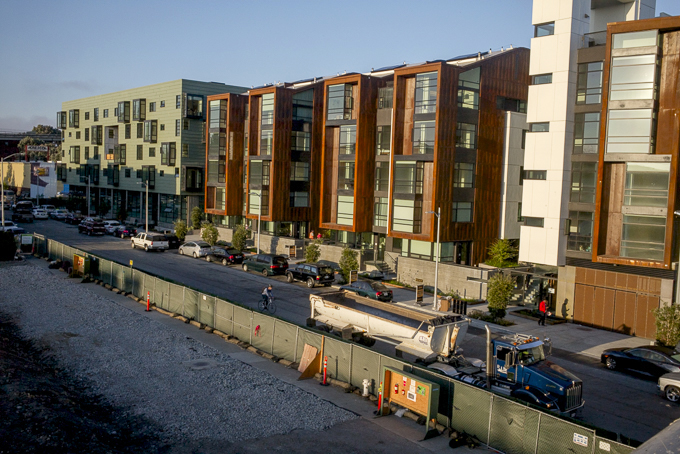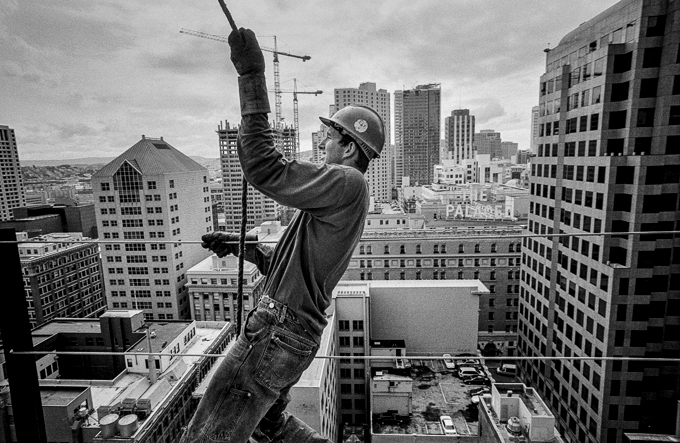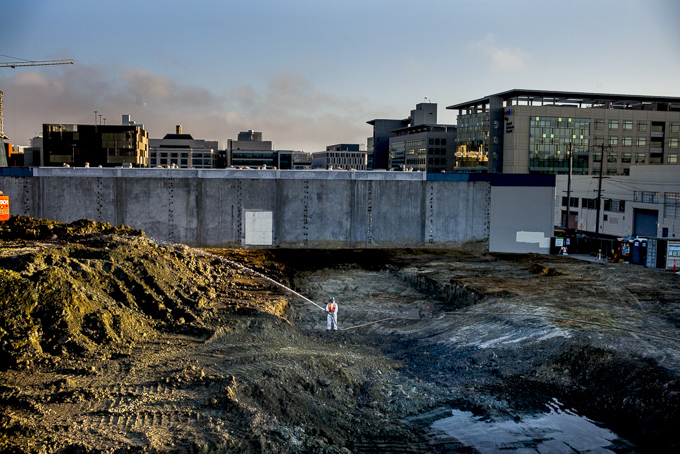Book Review – “The Way We Build: Restoring Dignity to Construction Work” by Mark Erlich
By Peter Olney

As I matured politically my searing impression of building trades unionism was the hardhat mob that attacked peace protesters on Wall Street in New York City in May of 1970. Peter Brennan head of the NYC Building Trades Council and later Secretary of Labor under Nixon led the attack.
But many strange personal, political and professional twists in intervening years brought me to a great appreciation of tradespeople and their unions. My oldest friend in the world, Hugh Kelleher, who I met in the spring of 1965 when we arrived at Philips Academy in Andover, MA , decided to become a union plumber in the 1980’s eventually turning out as a journeyman from Local 12 in Boston.
As my son Nelson was finishing high school in San Francisco, he indicated at a certain point that he didn’t want to go to college. He was doing fine in school so my wife and I were a little concerned. I told him, “Look, finish high school, go to college and get your degree. Then you can do like your “Uncle” Hugh and become a union plumber.” A few years after graduating from UCLA with a degree in philosophy he enrolled in an apprenticeship program with International Brotherhood of Electrical Workers (IBEW) Local 617 in San Mateo and turned out in 2015. Now he makes a great living, loves the work and is currently in Tokyo enrolling in a technical school that will enable him to work as an electrician anywhere in Japan. My friend Hugh’s son Cameron is also a union electrician out of IBEW Local 103 in Boston. Not bad for the sons of two Andover Academy graduates!

I think a better title for Mark Erlich’s book would be “Preserving and Extending the Dignity of Construction Work”. For our two sons, there is tremendous dignity and economic security. They work out of the hiring hall so they have flexibility in pursuit of their interests beyond work, and the pay and benefits are excellent. The question and challenge that Erlich describes is one of extending that dignity, the good wages, and benefits of the unionized trades to the vast non-union sector. This, of course, is not a charity mission, but a matter of self-preservation because if trends continue, the unionized trades will represent a tiny sliver of the market and their superior wages and conditions will be undermined.
In Chapter 1 entitled a Tale of Two Cities, referring to the contrast between union and non-union builders, Erlich presents stunning numbers that illustrate the decline of the unionized sector. In 1947 estimates had union construction at 87.1% of the market. Fast-forward to 2020 and that figure is a lowly 13.4%.[1] This decline is not some natural evolutionary phenomenon but the product of a concerted assault on construction unions begun in 1969. In Chapter 3 The Heavy Hand of the Business Roundtable, Erlich explains who was behind this concerted assault. The Construction Users Anti-Inflation Roundtable was founded by giant energy and manufacturing firms like US Steel who were concerned about the costs of construction during the Vietnam War. These corporate forces eventually aligned into what today has become the Business Roundtable. [2]
Here is J.C.Turner, General President – International Union of Operating Engineers (OE) in 1979 warning about the nature of the Roundtable:
“It has become apparent that a systematic and well planned campaign is being conducted to totally destroy the building trades… the current attack is the result of a decade of planning and groundwork by the Business Roundtable acting in concert with regional and local construction user associations, the contractor associations, the U.S. Chamber of Commerce, pro-business academic institutions and their allies in government… “
“Our real enemy is clearly these large industrial concerns, organized as the Business Roundtable, who are using the contractors and their associations as soldiers in the battle. Their purpose is to put the lid on costs by pressuring their construction contractors to slash wages… The Business Roundtable represents a threat not just to the building trades unions but to the trade union movement as a whole… “
“If corporate America can weaken the hard-won gains of this country’s construction unions, the ultimate target will be the entire trade union movement…” [3]
In this 112 page very accessible book Erlich describes the drop in union density and the relative decline in living standards. The construction unions still maintain their strongholds in major urban markets building high-rise commercial buildings and public works projects. Representation among residential construction workers however is almost non-existent.

Chapter 6 on Technology and the Future of Construction Work is very valuable in light of the general furor over AI and robots replacing traditional work. Erlich examines modular construction and new production processes but concludes that, “many of these advances remain novelty items available only to a minority of firms that have the resources and inclination to experiment with equipment and systems that have not consistently been proven to be quality or cost effective” [4]Erlich points out that “most union training programs have incorporated Computer Aided Design (CAD) and Building Information Modeling (BIM) into their curricula”[5] However in the end there remains the need for a skilled mechanic albeit employing labor saving precision tools. Nevertheless would not the trades be well served following the knowledge based technology work and stretching their jurisdiction to include the programmers and algorithm writers who are fashioning the CAD and BIM tools. These workers too are part of the construction process and would most certainly benefit from the power of the construction unions and their solidarity. No reason not to dream beyond the immediate physical workplace and leverage the power you have to control work upstream.
Chapter 8 focuses on Many Rivers to Cross: Organizing and Diversity and acknowledges that “the rapid growth of the Latino workforce added another dimension to the issues of organizing, diversity and inclusion”.[6]
Nowhere is this a more dramatic challenge than in California. The California economy is now #5 in the world in GDP trailing only China, the US, Japan and Germany![7] In the Golden State there are approximately 900,000 workers in construction. 600,000 of those workers are Latinos and 500,000 of those Latinos are non-union.
Erlich unfortunately ignores one of the most exciting developments in the history of immigrant worker organizing, the strike and organization of drywall carpenters in Southern California in 1992. The 3,000 “drywalleros” self organized and struck residential construction sites from San Diego to Santa Barbara and assisted by the United Brotherhood of Carpenters and Joiners of America (UBCJA) won an agreement with the drywall employer contractors. Their strike inspired Southern California labor as a largely Mexican immigrant workforce engaged in militant and provocative tactics even at one point blocking traffic on the Hollywood freeway at rush hour.[8]
The employers unleashed the police and the Immigration and Naturalization Service (INS) on the workforce and the Carpenters union provided training and attorneys to spring these workers from La Migra. This winning battle made a national name for Doug McCarron the SoCal Carpenters district director, and he rose to become national president in 1995 after Sig Lucassen retired. McCarron remains President to this day, and the UBCJA is controversial in the labor movement for its go it alone approach to construction jurisdiction. But the Carpenters, particularly in California, have been in the forefront of organizing immigrant workers.
The battle of the drywallers is instructive for organizers seeking to reverse the dramatic density drop in construction. The battle was waged as an area wide struggle against multiple contractors based in a regional labor market and supported by the Mexican community. The leaders of the effort were from a small village of 2000 residents in Guanajuato Mexico called El Maguey. The elders of the village had given “strike sanctions” to the workers and indicated that those who crossed the picket lines would not be welcome to return home at Xmas or Easter! [9] This phenomenon of immigrant workers is not unfamiliar to Erlich as he himself cites the presence of French Canadian immigrant workers in the New England drywall industry who filled a void left by “generalist carpenters who looked down on the work and left it to others to fill the vacuum.” Unfortunately the drywallers in this case did not self organize but were classified as individual contractors and super exploited.
Erlich was a reformer within his own union in New England having run for office and beat an incumbent based on his innovative approaches to organizing and politics. He does not however address the question of reform within the larger UBCJA union. Recently in Seattle, a reform group called the Peter J. McGuire caucus named after the original organizer of the UBCJA back in the 19th century, participated in a bitter strike in the Puget Sound.[10] Their role was controversial and the strike resulted in McCarron placing the regional council in trusteeship. It would be instructive to hear Erlich’s viewpoint on the questions of internal democracy!
Interest in this book has been largely confined to academic and industry circles. It needs to be read and discussed in trade union circles particularly in the construction trades.
Since my retirement from the International Longshore and Warehouse Union in 2013 I have been part of the adjunct faculty at the Building Trades Academy headquartered for accreditation purposes at Michigan State University. I have co-taught courses on organizing and bargaining for business managers and organizers from the Heat and Frost Insulators, Plasterers and Cement Masons and the Bricklayers. For Ironworker Lathers from NYC and the Central South Region of the UBCJA I taught classes on internal organizing. Erlich’s book would have been a perfect compliment to all those weeklong training sessions.
Now several national formations are springing up advocating for more democracy in the trades and for more focus on new organizing and green construction policies and projects.[11] Erlich’s “The Way We Build” is an instructive and engaging read for those just beginning to cut their teeth in construction organizing and union reform. …
[1] Erlich Page 6 and unionstats.com
[2] An excellent companion volume to Erlich’s work is Wars of Attrition: Vietnam, the business roundtable, and the decline of construction unions Marc Linder Fanpihua Press 2000
[3] JC Turner “The Business Roundtable and American Labor” May 1979
[4] Erlich Page 50
[5] Erlich Page 54-55
[6] Erlich Page 79
[7] https://www.forbes.com/places/ca/?sh=4ae284f73fef
[8] https://ecommons.cornell.edu/server/api/core/bitstreams/0251c537-6a21-4081-bf90-7a5136bfbff9/content
https://www.latimes.com/archives/la-xpm-1992-07-24-me-3937-story.html
[9] I visited the village of El Maguey in the summer of 2000 and met with elders who were relatives of Jesus Gomez, the principal organizer of the drywall strike.
[10] https://council.seattle.gov/2021/09/19/rank-and-file-carpenter-nina-wurz-we-need-a-good-contract-and-rent-control/
[11] https://www.resilience.org/stories/2022-06-10/unions-making-a-green-new-deal-from-below-part-1/
“The Way We Build: Restoring Dignity to Construction Work” by Mark Erlich
…